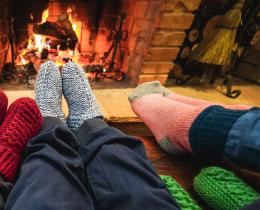Omega: Can you talk about your experience with Lyme disease and describe how you used mindfulness to help you heal?
Sister D: I owe deep gratitude to Dr. Richard Horowitz, who has helped me on this journey. When I moved to Blue Cliff Monastery in Pine Bush, New York, I was suffering greatly with Lyme disease. One of our longtime practitioners heard about this and asked me if it was okay that she talk to her Lyme specialist on my behalf. She wrote him a letter and actually sent him a copy of my book, Healing.
Within a week his secretary called and gave me an appointment. He told me that he appreciated the spiritual life but couldn’t let go of everything to become a monk. He also said he felt companionship because I’m also trained as a doctor. He took care of me for two and a half years.
In Mindfulness as Medicine, I talk about my experience with Lyme and how I have used, and continue to use, mindfulness to help me heal. The first important practice to learn is to have awareness of the body, and to heal it in every moment. With Lyme disease there is chronic pain. Your joints are chronically swollen. Today this one is swollen but tomorrow it could jump to another one. The inflammation causes pain and limited range of motion. For instance, I can no longer put my right arm onto my back like I could before. Others may not be able to see it, but I feel it every moment. And there is fatigue—I can be energetic this moment, but after I talk to you, I will have to lie down.
Lyme disease has changed my personality in many ways. I used to do a lot of hiking and was very active, but now I lay low a lot more. I cannot do vigorous activities for so long anymore. In that way it’s debilitating, and yet we have to suffer it silently.
Learning to be aware of the body in every moment, to relax the tension and the pain, and to speak lovingly toward ourselves helps us heal in every moment. Don’t expect others to be empathetic or offer help—you have to be there for yourself, to be nurturing, kind, and attentive to yourself. With loving speech and deep listening, you can learn not to push your own limits out of pride or despair, and to rest when you need it.
Omega: Are you saying healing is not necessarily the disappearance of disease; it’s the disappearance of suffering?
Sister D: Healing does not mean that you don’t have an illness or that you don’t have any problems. Healing just means that you can be at peace with yourself and with what was, what is, and what will be. Mindfulness helps us to do this. When we are our own soul mate, when we are aware of our own body and mind, the fear can subside. The angst and worry that we have in reaction to a difficult situation or to an illness is due to the fact that we cannot be with ourselves and with what is. But when you can sit or lie down or stand and breathe with what is, that’s healing right there. You embrace and transform the suffering.
There is a teaching that pain is inevitable, but suffering is optional. We may have physical or mental pain—our neurons are always firing and that will result in bodily sensations, thoughts, perceptions, and feelings, both pleasant and unpleasant—but if we know how to relax, how to be there for them, then even if the pain is inevitable, the suffering is optional. Pain is usually temporary and fluctuating in degrees, but suffering can be relentless and throughout our life. Often, we are the ones feeding our own suffering with negative thoughts, speech, and behaviors.
This is reflected in the teaching of the second arrow by the Buddha. The first arrow, a difficult situation or illness, is hard. But if you try to run away from it or become too stressed, anxious, or worried, that is like shooting a second arrow into the wound. It makes it so much worse. Equanimity is very important, and mindfulness helps us to see what is as it is.



